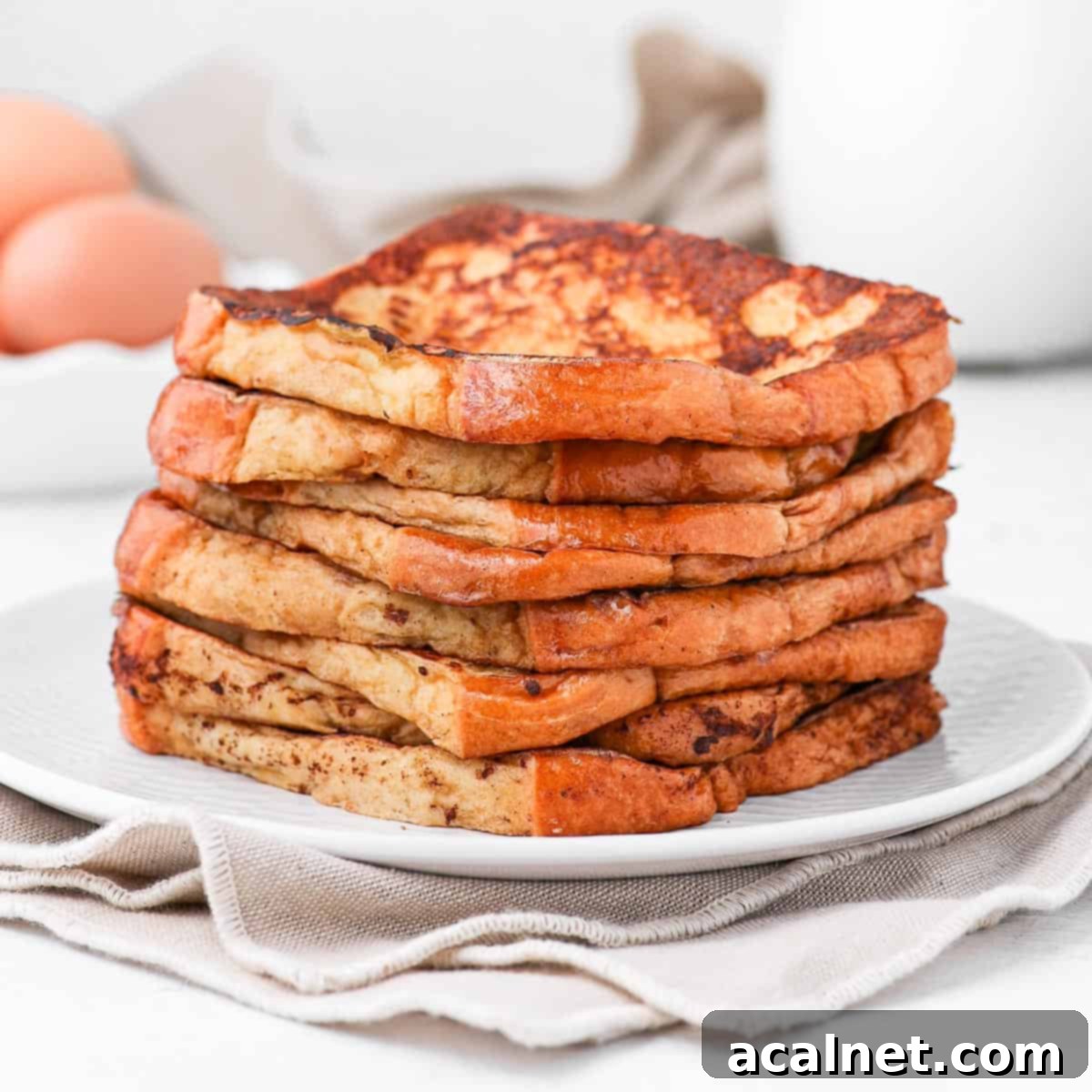Decadent Brioche French Toast: The Ultimate Recipe for a Luxurious Breakfast
Prepare to elevate your breakfast or brunch experience with this ultimate Brioche Bread French Toast recipe. Renowned for its unparalleled richness and tender texture, brioche bread transforms ordinary French toast into an extraordinary culinary delight. Each thick slice of sweet, buttery brioche is lovingly dipped into a fragrant custard mixture of milk, egg, and cinnamon, then griddled to golden perfection. The result? A breakfast masterpiece that is irresistibly fluffy and soft on the inside, with wonderfully caramelized, slightly crispy edges – a truly unforgettable way to start your day.

Why You’ll Adore This Brioche French Toast Recipe
There are countless reasons why this easy brioche French toast recipe consistently earns rave reviews and becomes a family favorite. It’s more than just a breakfast; it’s an indulgent experience that brings joy to any morning or leisurely brunch. Here’s why this recipe stands out:
- Unrivaled Texture and Flavor: The secret truly lies in the brioche itself. This rich, buttery bread, with its natural sweetness and soft, airy crumb, is the ideal canvas for French toast. When soaked in our carefully balanced custard of eggs, whole milk, aromatic cinnamon, and fragrant vanilla, it creates a custardy interior that melts in your mouth, contrasted beautifully with golden-brown, slightly crisp edges achieved by pan-frying.
- Decadently Delicious: This isn’t your average French toast. The inherent richness of brioche means you start with a superior base, resulting in a profoundly satisfying and decadent flavor profile that’s hard to beat. It feels like a treat, making any meal feel special.
- Simple Yet Impressive: Despite its luxurious taste and appearance, this recipe is surprisingly straightforward to make. With just a few basic ingredients and simple steps, you can create a breakfast that looks and tastes like it came from a gourmet cafe.
- Versatile for Any Craving: While classic maple syrup is always a winner, this brioche French toast truly shines with a variety of toppings. Whether you prefer the tart sweetness of a Strawberry Compote or Blueberry Compote, the warming notes of Stewed Pears, or the bright tang of Lemon Curd, the possibilities are endless. This means you can enjoy it differently every time and never tire of it!
- A Family Favorite: The combination of sweetness, fluffiness, and a hint of spice appeals to all ages, making it a guaranteed hit for family breakfasts, holiday brunches, or simply a weekend treat.
Looking for a different take on this classic? Give my Brioche French Toast Casserole a try for a convenient make-ahead option!
Essential Ingredients for Perfect Brioche French Toast
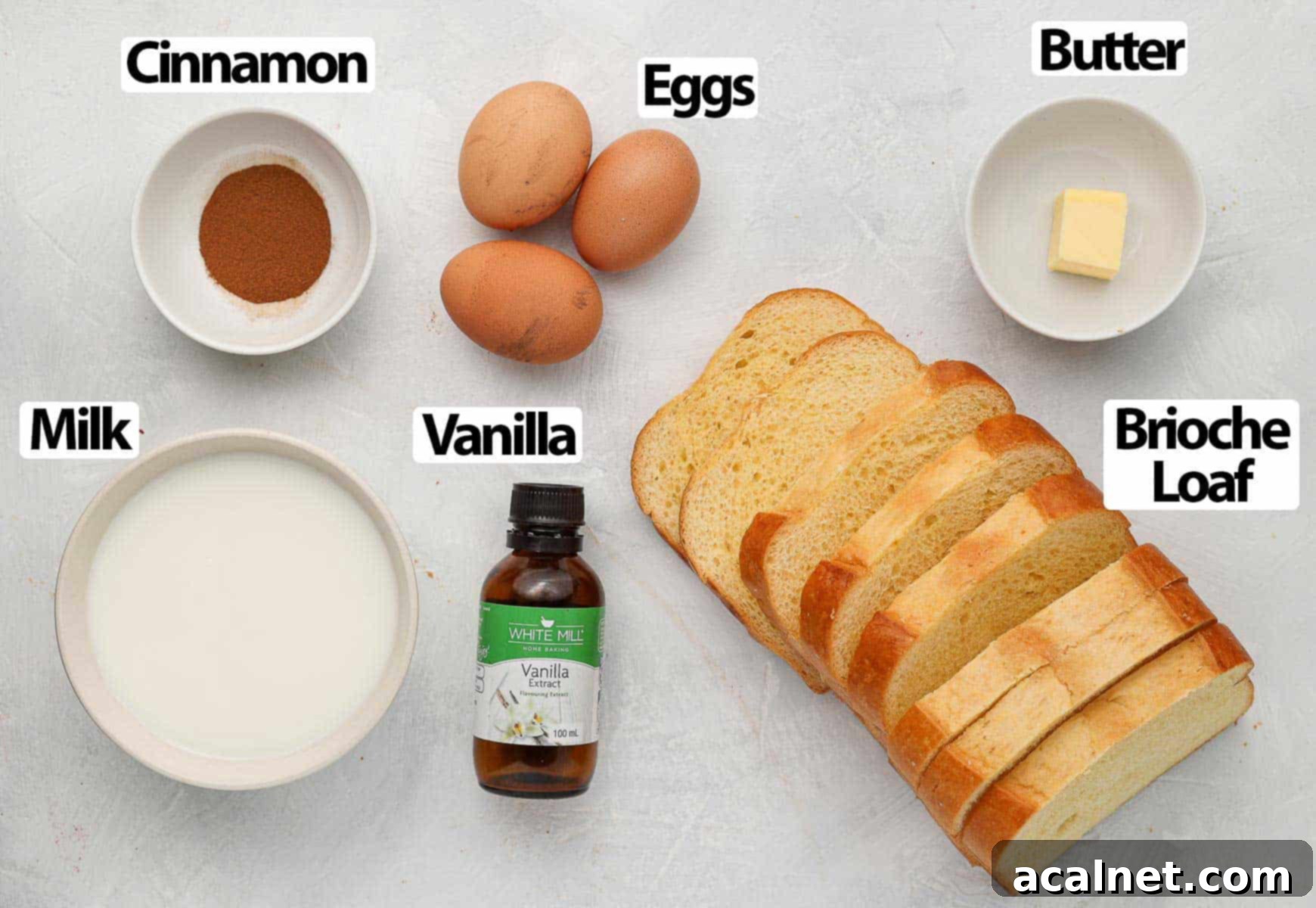
Creating truly outstanding French toast starts with high-quality ingredients. While the core recipe relies on just a few basics, each component plays a crucial role in achieving that perfect taste and texture:
- Brioche Bread: This is the star of our show! You can use either a store-bought brioche loaf or a delightful homemade version. For the absolute best results, opt for brioche that is a day or two old (slightly stale). This allows it to absorb the custard mixture without becoming overly soggy. French Toast, after all, was originally known as “pain perdu” or “lost bread,” invented precisely to make use of leftover bread.
- Eggs: Use medium-sized eggs, ideally at room temperature. Room temperature eggs blend more smoothly with the milk, creating a more uniform custard and ensuring even coating on your brioche slices.
- Milk: For the richest flavor and most luxurious texture, full cream or whole milk is highly recommended. However, any type of milk you have on hand will work perfectly fine.
- Cinnamon: An optional but highly recommended addition! Ground cinnamon adds a warm, comforting aroma and a subtle spicy note that perfectly complements the sweetness of the brioche. It truly elevates the flavor profile.
- Vanilla Extract: Another optional but fantastic enhancer. A good quality vanilla extract or essence adds depth and a sweet, aromatic fragrance to the custard.
- Unsalted Butter: Used to grease your skillet or pan, butter not only prevents sticking but also imparts a beautiful golden color and a superior, rich flavor to the cooked French toast slices. While oil can be used as a substitute, butter undeniably enhances the taste.
Optional Additions & Substitutions to Customize Your French Toast
- Sugar: Brioche bread is inherently sweet, so I personally find additional sugar unnecessary in the custard mixture. However, if you prefer an extra sweet French toast, feel free to add one or two tablespoons of white or brown sugar to the egg mixture. A small pinch of salt (about 1/4 to 1/3 teaspoon) can also be added to balance the sweet flavors and enhance the overall taste.
- Dairy-Free Milk: To make this French toast dairy-free, simply substitute whole milk with your preferred plant-based milk, such as almond milk, oat milk, or soy milk. Keep in mind that using flavored plant milks (like vanilla almond milk or coconut milk) will subtly alter the final flavor of your French toast.
- Challah Bread: As a fantastic dairy-free alternative to brioche, Challah bread works wonderfully! It shares many characteristics with brioche, including a rich, tender crumb, making it an excellent choice for French toast.
How to Master Brioche French Toast: Step-by-Step Guide
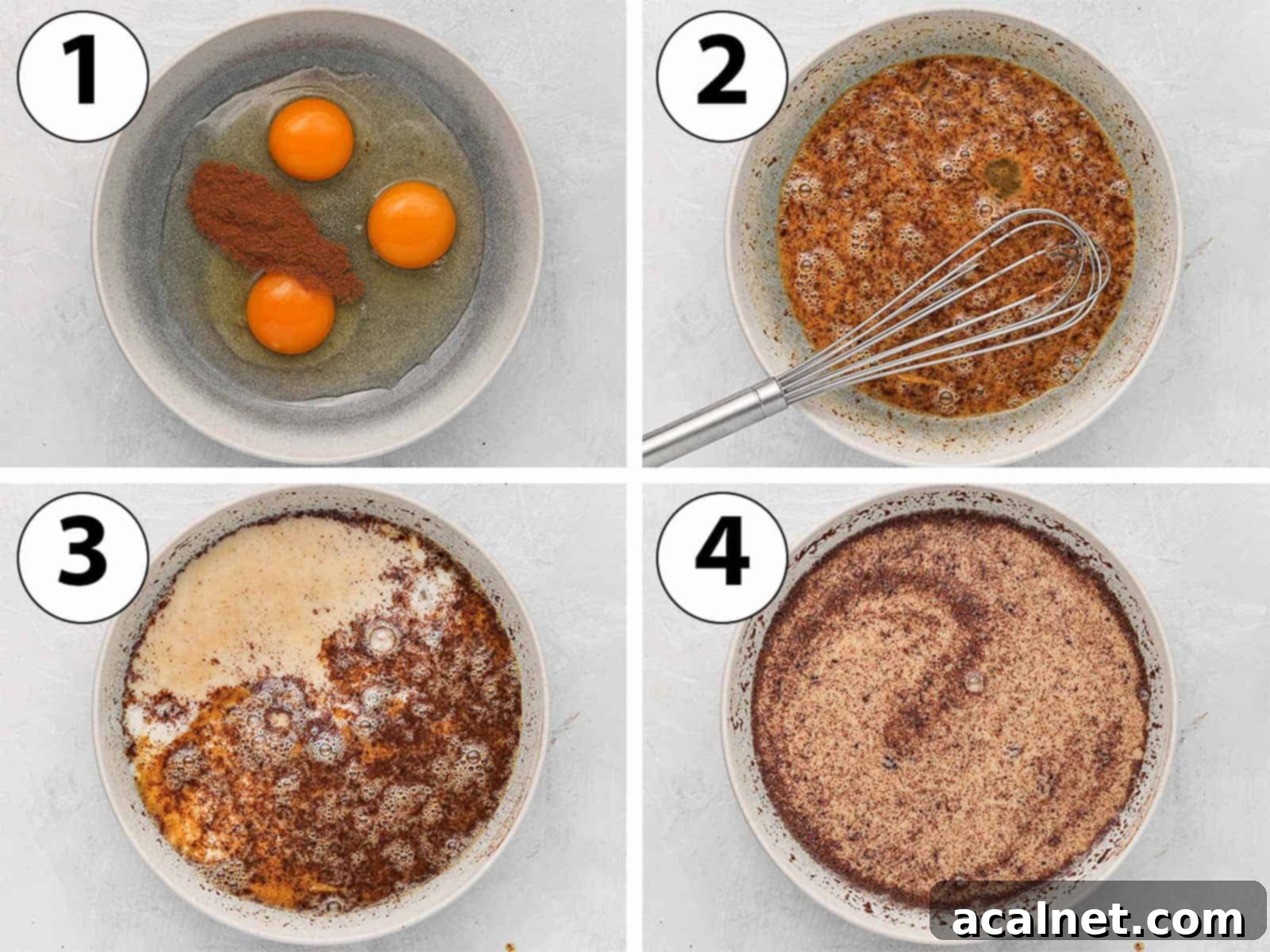
Making delicious brioche French toast is a simple process that yields incredibly rewarding results. Follow these steps for perfect fluffy and crispy slices every time:
- Prepare the Brioche: If you’re using a whole loaf, begin by slicing your brioche into thick, even slices. The thickness of your slices is key to the final texture – aim for about 3/4 to 1 inch thick. This ensures a substantial interior that can absorb enough custard without falling apart (see FAQs section for more details on thickness).
Creating the Custard Mixture:
- Photo 1: Combine Eggs & Cinnamon: In a large, shallow bowl (a pasta bowl or a wide baking dish works great for easy dipping), crack your eggs and add the ground cinnamon.
- Photo 2: Whisk Thoroughly: Vigorously whisk the eggs and cinnamon together for about a minute or two, ensuring the egg yolks and whites are completely blended. Don’t worry if the cinnamon doesn’t fully dissolve; this is normal and won’t affect the flavor.
- Photo 3: Add Milk & Vanilla: Pour in the milk and vanilla extract (if using).
- Photo 4: Final Whisk: Whisk everything together until well combined. Again, you might notice small specks of cinnamon, which is perfectly fine.
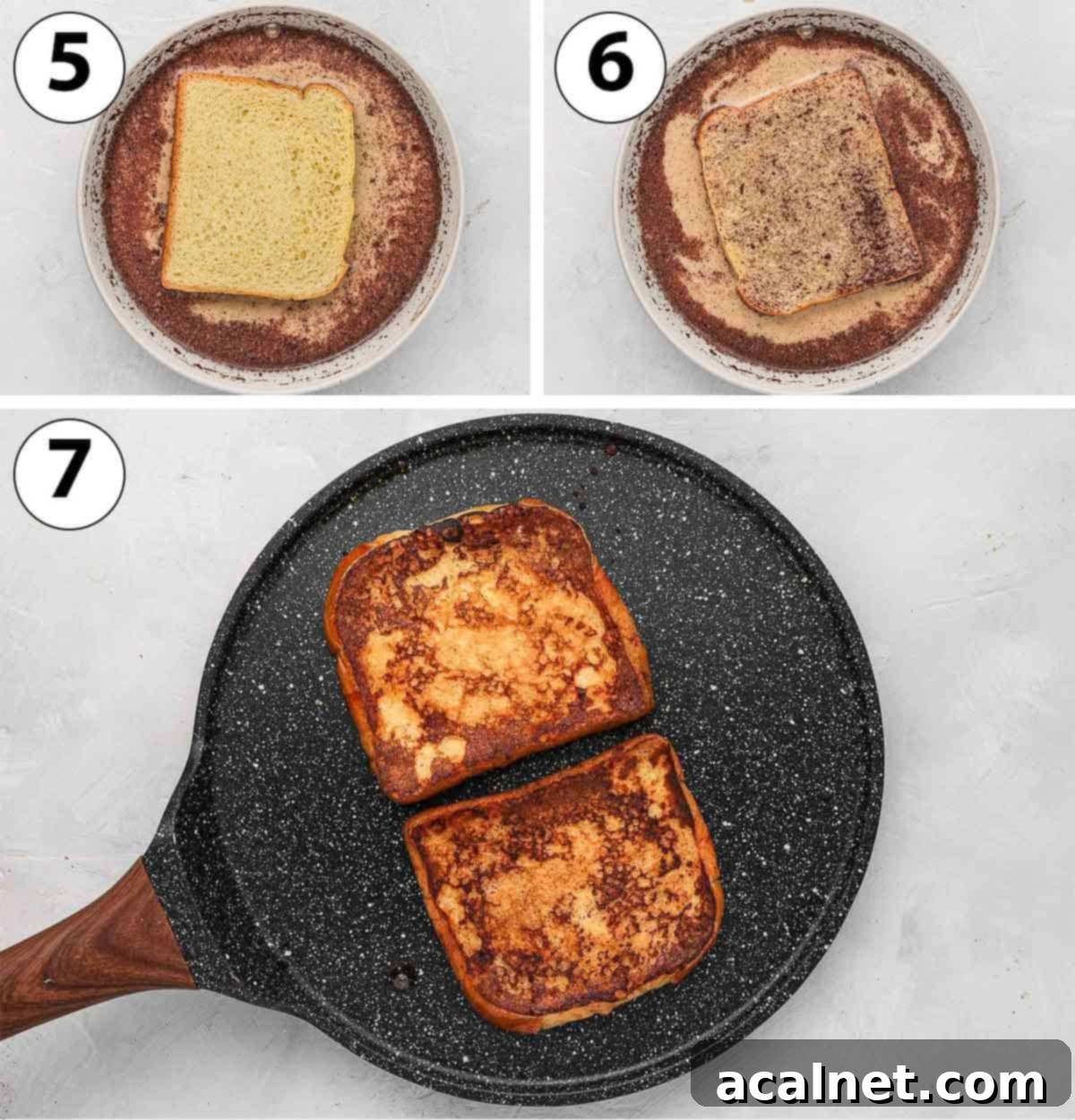
Soaking the Brioche and Cooking to Perfection:
- Preheat Skillet: Place a large skillet or non-stick pan (a crêpe pan works exceptionally well!) over medium heat. Allow it to heat up for a few minutes. Once warm, lightly grease the pan with a pat of butter or a tiny bit of oil. Maintain a medium heat; too low will make the toast dry, and too high will burn it before the inside cooks.
- Photo 5: Dip Each Slice: Take one slice of brioche and carefully dip it into the custard batter. Allow it to soak for about 30 seconds to 1 minute per side. The exact soaking time depends on the freshness of your bread and your desired texture (see “Tips for Success” below).
- Photo 6: Check Saturation: After soaking on both sides, the bread should feel noticeably heavier and slightly soft, but not on the verge of breaking apart. If it feels too fragile or starts to tear, it means either you’ve soaked it for too long or your slices were cut too thin.
- Photo 7: Cook to Golden Brown: Gently place the soaked brioche slice onto the preheated skillet. Cook for 1 to 2 minutes on each side, or until it achieves a beautiful golden-brown color and a nicely caramelized crust. The exact cooking time will vary depending on your stove’s heat and the thickness of your bread. For a softer, more custardy brioche French toast, cook it for slightly longer at a lower temperature. For crispier edges, cook it a bit more quickly at a slightly higher temperature.
- Serve Immediately: Remove the cooked French toast slices from the pan and transfer them to a serving plate. Repeat this process with the remaining brioche slices, adding more butter to the pan as needed. It’s a good idea to re-whisk the custard mixture occasionally between toasts to ensure the cinnamon remains evenly distributed.
- Enjoy Warm: Serve your delicious brioche French toast immediately while it’s still warm, topped with your favorite breakfast toppings.
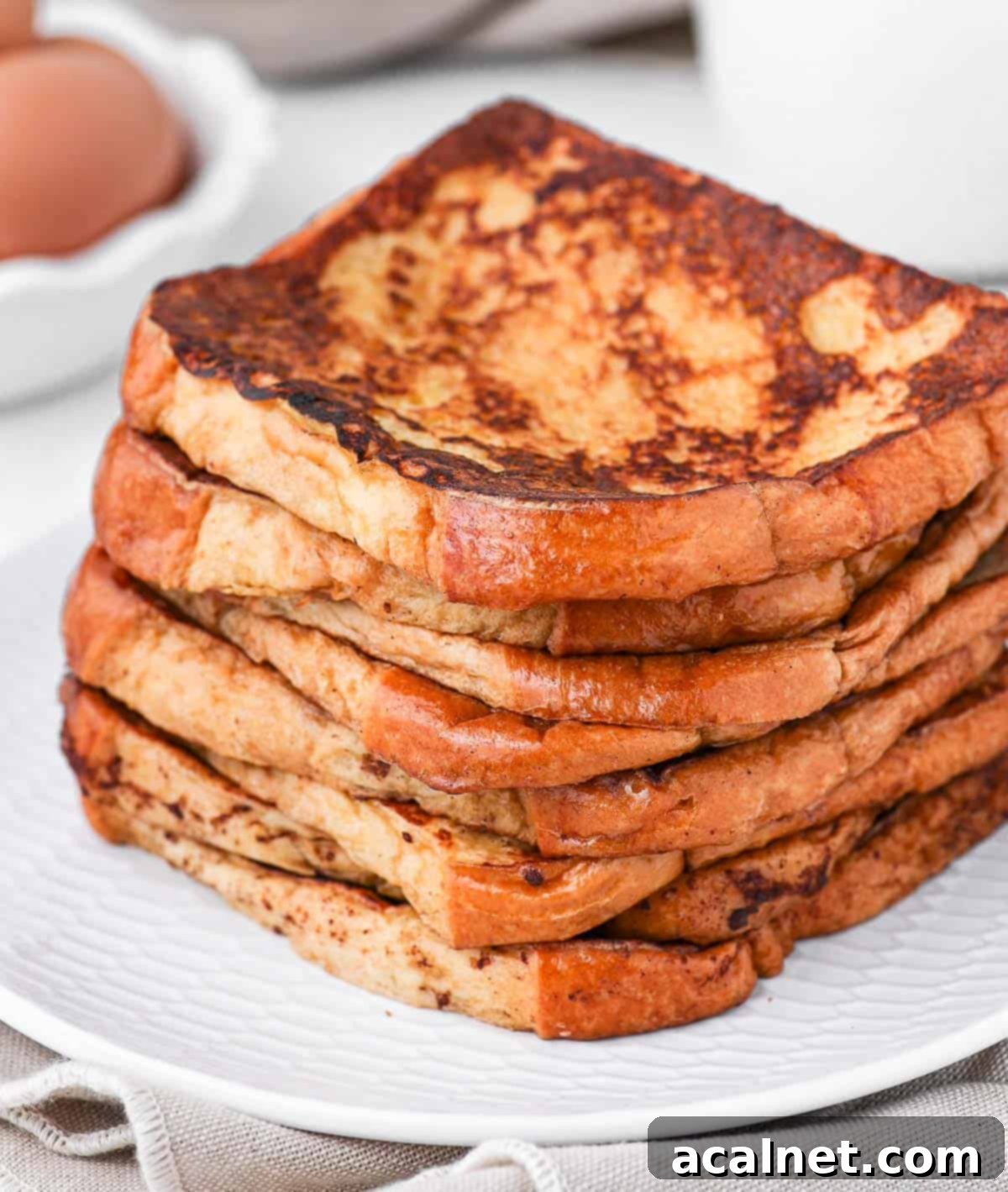
Frequently Asked Questions About Brioche French Toast
Brioche is classified as an “enriched bread.” Unlike leaner breads, it’s made with a higher content of fat from butter (and sometimes oil), a significant amount of eggs, and often milk instead of water. This rich composition gives brioche its signature tender crumb, golden color, and subtly sweet, buttery flavor, making it exceptionally soft and decadent.
Absolutely! Challah bread is very similar to brioche in its enriched nature, often featuring eggs and a tender crumb, making it an excellent substitute. Most traditional challah bread recipes are also dairy-free, which can be an added benefit if you’re looking for a non-dairy option without compromising on texture and richness.
Both homemade and store-bought brioche work wonderfully! If you enjoy baking, using a homemade loaf like my classic Brioche Bread Loaf, or even more creative versions like Chocolate Chip Brioche or Chocolate Swirl Brioche, can add an extra layer of satisfaction. Regardless of its origin, I highly recommend using brioche that is a few days old (slightly stale). Older bread holds its shape better and absorbs the custard more effectively without becoming overly mushy, resulting in superior French toast.
The ideal thickness is a matter of personal preference, as it significantly impacts the final texture of your French toast. Thinly sliced brioche will cook faster and be crispier, but runs the risk of becoming soggy if over-soaked. Thick slices (around 3/4 to 1 inch) will yield a more custardy interior and require a slightly longer soaking time to fully absorb the batter, as well as a bit more cooking time. Experiment to find your perfect balance of crispiness and tenderness!
Yes, you can absolutely prepare the custard mixture a few hours in advance, or even the night before! Simply whisk all the ingredients together as instructed, cover the bowl tightly with plastic wrap, and refrigerate. Give it a quick whisk again just before dipping your brioche slices to ensure everything is well combined.
Delicious Topping Ideas for Your Brioche French Toast
While brioche French toast is a delight on its own, it truly shines when paired with complementary toppings. Here are some delectable ideas to elevate your breakfast:
- Classic Syrups: A generous drizzle of pure Maple Syrup or golden Honey is always a crowd-pleaser, providing natural sweetness and a beautiful sheen.
- Fresh Berries: Simply scattering fresh raspberries, blueberries, strawberries, or mixed berries over your warm French toast adds a burst of freshness, color, and a light tang that cuts through the richness.
- Homemade Compotes: A warm, fruity compote is a fantastic addition. Try an Easy Raspberry Compote (as shown in the photos!), a vibrant Mixed Berry Compote, a sweet Blueberry Compote, or a luscious Strawberry Compote. These fruit sauces add a delightful texture and concentrated flavor.
- Light & Refreshing Coulis: For a lighter, silky smooth fruit experience, opt for a coulis. Options like Strawberry Coulis, exotic Passion Fruit Coulis, tropical Mango Coulis, or sweet Blueberry Coulis are all wonderful choices.
- Indulgent Creams & Sauces: For a truly decadent treat, consider toppings like a velvety Vanilla Pastry Cream, a rich Whipped Ganache Frosting, a scoop of refreshing Passion Fruit Ice Cream, or simply a dollop of freshly whipped cream.
- Nut Butter & Bananas: For a more filling option, spread your favorite nut butter (peanut, almond, or cashew) and top with sliced bananas and a sprinkle of chopped nuts.
- Powdered Sugar: A simple dusting of powdered sugar adds an elegant finish and a touch of sweetness.
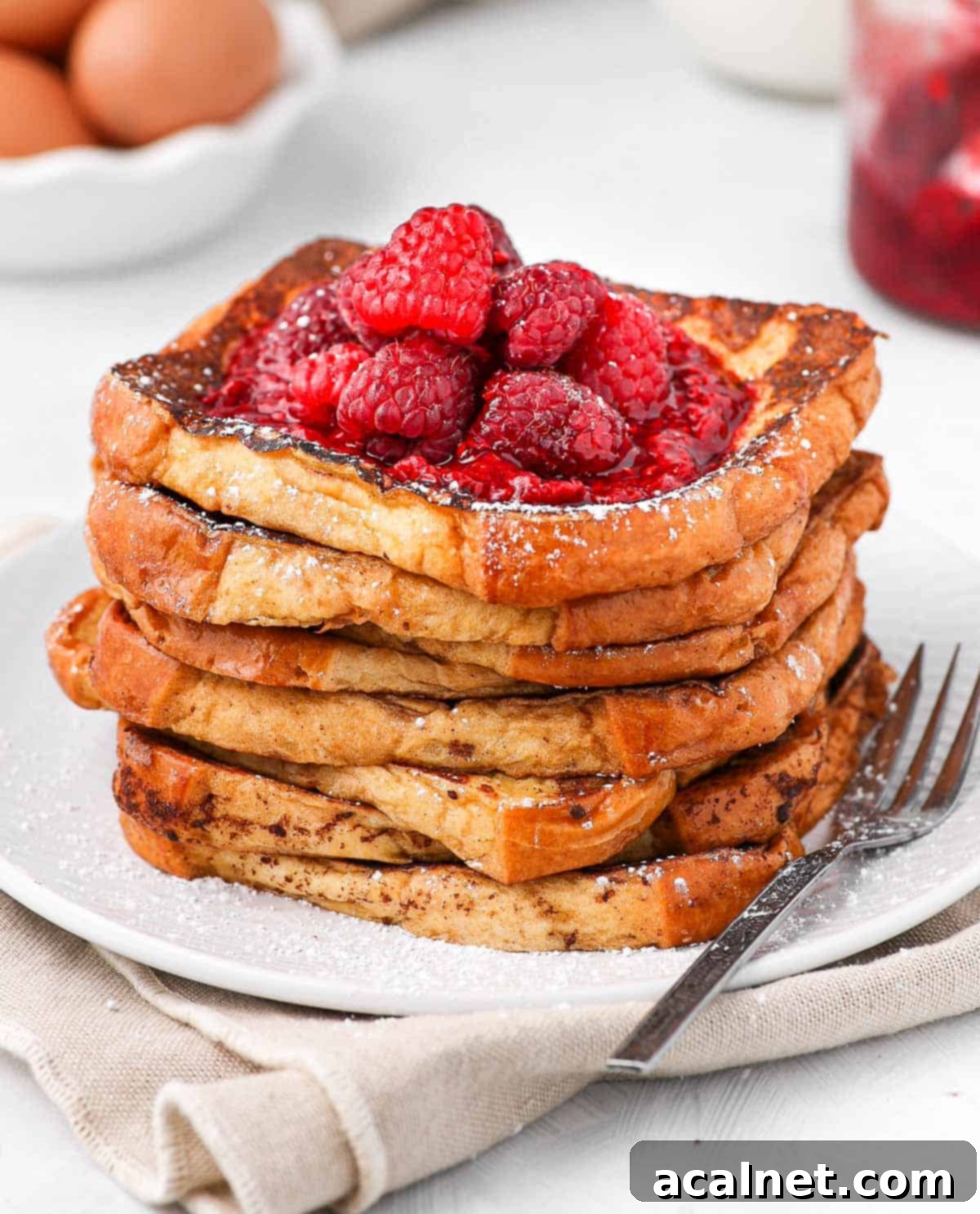
Expert Tips for the Best Brioche French Toast
Achieving perfectly cooked brioche French toast is easy with a few simple tricks up your sleeve. Follow these tips to ensure a successful and delicious outcome every time:
- Avoid Soggy French Toast: The key to preventing a soggy center is a delicate balance. First, ensure your brioche slices are thick enough (at least 3/4 inch). Second, don’t over-soak the bread in the custard mixture; 30 seconds to 1 minute per side is usually sufficient for stale brioche. Third, cook your French toast over medium heat – not too low, which can dry it out, and not too high, which can burn the outside before the inside cooks through. Finally, serve your French toast immediately after cooking for the best possible texture!
- Achieve Super Crispy Edges: If you love a really crispy exterior, here are two methods:
- Pre-toast: Lightly toast your brioche slices in a toaster or oven for a minute or two before dipping them in the custard. This creates a slightly firmer base that crisps up beautifully when cooked.
- Grill Finish: After pan-frying, you can transfer your French toast to a grill (or broiler) for a couple of minutes on each side. Watch carefully to prevent burning!
- Use Slightly Stale Brioche: As mentioned, brioche that is a day or two old is ideal. Stale bread has lost some moisture, making it more absorbent and less likely to fall apart when soaked in the liquid custard. This tradition dates back to the very origins of French toast, known as “pain perdu” (literally “lost bread”), a clever way to repurpose leftover bread.
- Monitor Custard Absorption: This recipe is designed to yield 6 to 8 slices of French toast. However, depending on the specific brand of brioche you use, how thickly it’s cut, and how long you soak each slice, you might find that you use all the custard before cooking every single slice. It’s always a good idea to have a little extra milk and egg on hand if you need to quickly whip up more batter.
- Scaling the Recipe: This recipe is incredibly easy to scale. If you’re feeding a larger crowd, simply double or triple the ingredients for the custard mixture and ensure you have enough brioche slices.
- Even Cooking is Key: To ensure all slices cook evenly, avoid overcrowding your pan. Cook only as many slices as can comfortably fit in a single layer without touching. This allows for better heat distribution and even browning.
Storing & Reheating Leftover Brioche French Toast
While brioche French toast is best enjoyed fresh off the griddle, you can certainly store leftovers for a quick indulgence later:
To store leftover brioche French toast, first allow the slices to cool completely to room temperature. Once cooled, place them in an airtight container or a resealable bag. Store in the refrigerator for up to one day. For the best texture, I highly recommend consuming them within this timeframe, as French toast can become quite soggy if stored for too long.
When it comes to reheating, for the crispiest results, your best options are the oven or a skillet. Preheat your oven to 350°F (175°C) and warm the French toast for about 5-10 minutes, or until heated through and edges are crisp. Alternatively, reheat in a lightly greased pan on the stove over medium heat until golden and warm. If you prioritize speed and don’t mind a slightly softer, less crispy texture, the microwave can also be used, heating for 30-60 seconds per slice. I do not recommend freezing French toast; they tend to lose their delicious shape and appealing texture after thawing and reheating, often becoming very mushy.
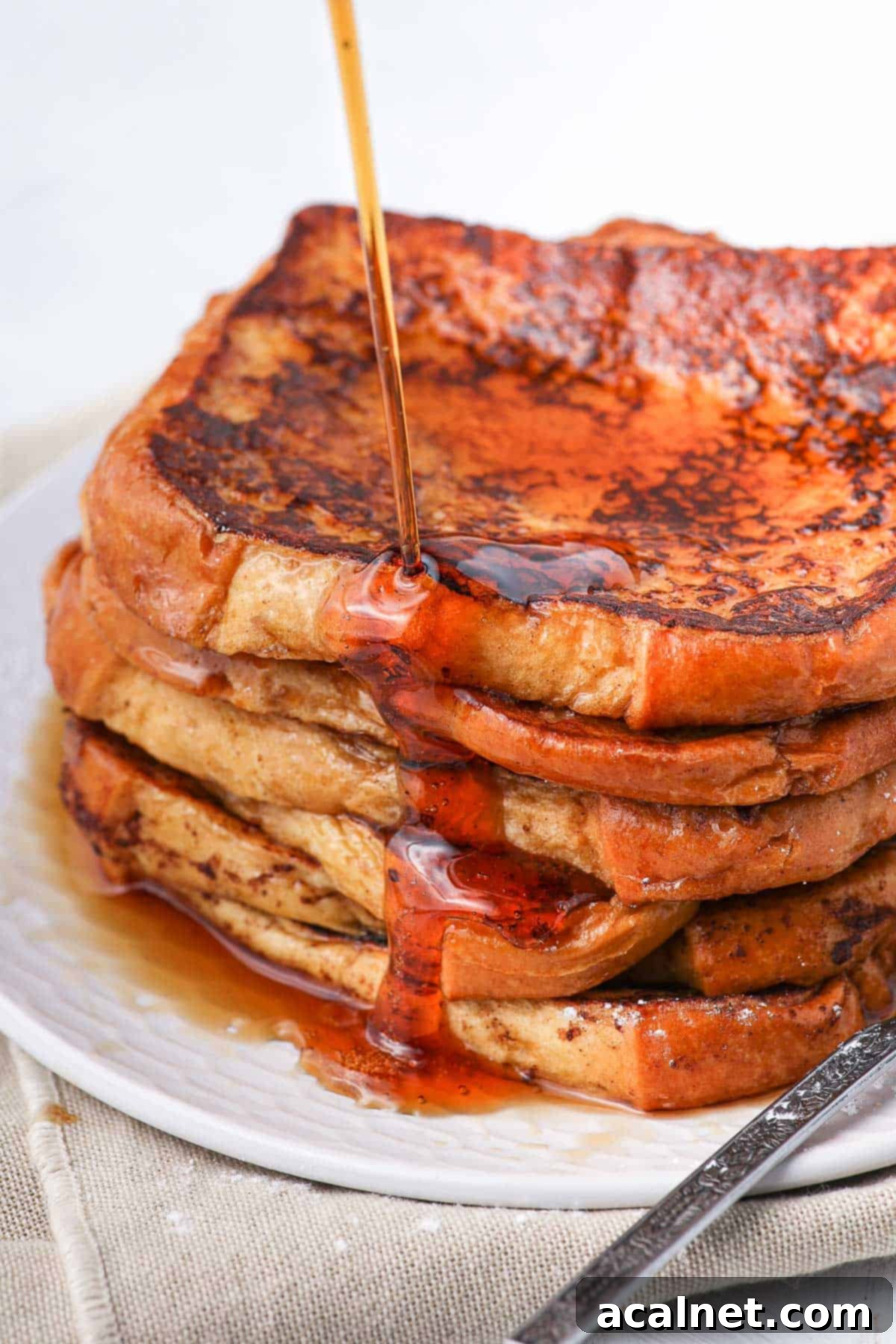
More Irresistible Breakfast & Brunch Recipes
If you loved this brioche French toast, you’ll certainly enjoy exploring more delightful breakfast and brunch creations. Here are some other recipes to inspire your next morning meal:
- 3-Ingredient Banana Pancakes (Sugar-Free)
- Triple Chocolate Cinnamon Rolls
- Cinnamon Roll Bread Loaf
- Cinnamon Babka
- Apple Cinnamon Baked Oatmeal
- Croissant French Toast Bake
Made this recipe?
We’d love to hear from you! Let us know if you enjoyed it by leaving a comment below, and don’t forget to tag us on Instagram @a.baking.journey with a photo of your delicious creation!
Recipe Card

Brioche Bread French Toast
Servings:
8 French Toast Slices
Author:
Sylvie
10 minutes
25 minutes
35 minutes
Print Recipe
Prevent your screen from going dark
Ingredients
- 3 Eggs, medium size
- 1 teaspoon Ground Cinnamon
- 180 ml (3/4 cup) Full Cream / Whole Milk
- 1 teaspoon Vanilla Extract, optional
- 8 slices Brioche Bread
- 1 teaspoon Unsalted Butter, for greasing the pan
Instructions
- If using a whole brioche loaf, start by cutting it into thick slice (see note 1).
- Whisk together the eggs and cinnamon in a large shallow bowl or baking dish for a minute or two – or until the egg yolks and whites are well blended (see note 2). Add the Milk and Vanilla and whisk until combined.
- Preheat a large skillet or non-stick pan on medium heat and grease it with a little bit of butter (or oil).
- Dip the brioche slice in the custard batter one at a time. Let it soak for 30 seconds to 1 minute per side (see note 3).
- Place the soaked slice on the preheated skillet and cook for a minute or two on each side (see note 4). They should be golden brown and nicely caramelised on each side. I don’t recommend cooking more than 2 slices at a time.
- Remove the cooked french toast slice from the skillet and place on a serving dish. Repeat until you have cooked all the brioche bread slices. Re-whisk the custard between each toast to insure the cinnamon is well blended.
- Serve straight away while still warm with your choice of topping.
Would you like to save this recipe?
We’ll email this post to you, so you can come back to it later!
Notes
- Brioche bread is already quite sweet so I personally do not feel the need to add extra sugar to this recipe – but you could absolutely add one or two tablespoons of white or brown sugar if you want!
- Depending on the brand of brioche you use and how long you soak them for, you might run out of custard before you make 8 french toast slices.
Instruction Notes:
- The thickness of the slices will affect the overall texture of the dish, from crispy to soft. A thick slice will need to soak for a little bit longer to absorb all the custard, and will also need to cook for longer. A slice that is too thin might get soggy.
- Cinnamon tends to not blend with liquid ingredients so don’t worry if it doesn’t look smooth.
- The time you let it soak will change the texture. I personally find that a quick but thorough soak gives a french toast that is still soft in the middle bit nice and crispy on the edges.
- The exact time will depend on your stove heat, the thickness of the bread slice and the texture you are after. For a softer brioche french toast, cook it for a little bit longer on a lower temperature. For a crispier french toast, cook it more quickly at a higher temperature.
Nutrition (per serving)
Check out the Brioche Bread French Toast Web Story!
